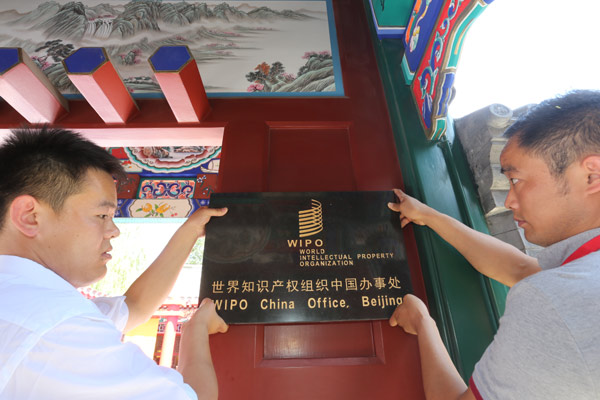 |
|
Employees fix the signboard of WIPO China Office during its inauguration on July 10. [Dai Bing / China Daily] |
Innovation in China has increasingly been a key influence for the global knowledge economy, according to World Intellectual Property Organization Director-General Francis Gurry.
Gurry said that he has "absolutely no doubt" that China will be recognized as an innovative economy in the near future, and itwill produce a growing amount of innovative industrial and creative content to share with the world.
"When you see the amount of attention paid by leaders to the economic strategy of innovation, and the amount of investment into research and development, China must be able to produce an innovative economy," Gurry said.
Gurry spoke at the third Innova BRICS Summit in London, where executives gathered to discuss innovation in emerging markets. It was held at Deloitte LLP's London office, attended by about 100 people.
China accounted for 29 percent in the growth of total Patent Cooperation Treaty applications filed through the WIPO in 2013, the organization's statistics show. This makes China the third-largest user of the PCT system after the United States and Japan.
 |
| Top 10 most innovative companies in world |
 |
| Ramping up R&D investment |
The PCT is an international treaty with more than 145 contracting states. The treaty makes it possible to seek patent protection for an invention simultaneously in many countries by filing a single "international" patent application.
In July, WIPO opened its Beijing office, its fifth overseas office after Brazil, Japan, Singapore and Russia. Established in 1967, the Geneva-based WIPO is a specialized agency of the United Nations.
Gurry said that the high number of patents filed in China is encouraging, because it reflects the nation's research and development output and the amount of research-based products that China has invested in.
Gurry also praised the Chinese government's efforts to strengthen intellectual property protection and regulations.
"It's been extraordinary what China has done, as it's only been 30 years since the first patent law was introduced in 1984. And in these 30 years, China has built a world-class intellectual property and innovation infrastructure. That is a massive effort in a very short, concentrated time," Gurry said.
One big challenge, particularly in developing markets, is the commercialization of innovation. China is leading the emerging markets in commercialization, although it still is not as strong as some developed markets such as the US, Gurry said.
He said that China's commercialization of innovation has been good in the telecommunications and information technology sectors, citing Huawei Technologies Co Ltd, ZTE Corp, Lenovo Group Ltd, Tencent Holdings Ltd and Baidu Inc as examples of innovators.
Innovations in China's biomedical sciences, advanced manufacturing and design sectors are just beginning and more can be done to realize these sectors' potential, Gurry said. "Commercialization is the most difficult area of all," Gurry said.
He said that China has the right talent and institutions in place to facilitate commercialization, but it needs time to develop the market sophistication that is important for commercialization.
An interesting trend of innovation in emerging economies is the growth of user-driven innovation, compared with the more traditional producer-driven innovation in developed markets, Gurry said.
One example of user-driven innovation is the hand-held electrocardiogram popular in developing economies including China, whose innovation is both producer-driven and user-driven, he said.
